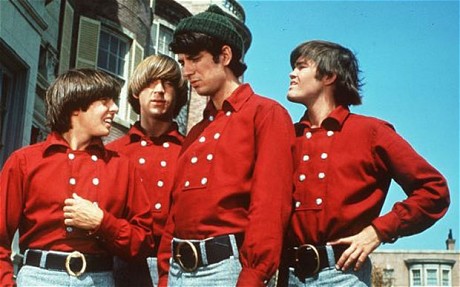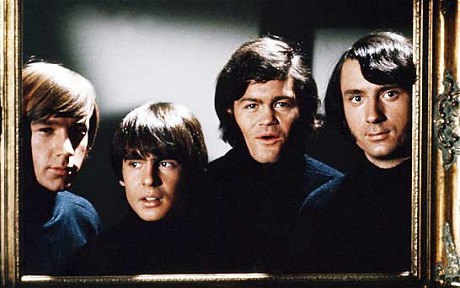Monkees swing back into town
The original boy band is attracting a new generation of believers, says Helen Brown .
By Helen Brown
In September 1965, the Hollywood Reporter ran a wanted ad for “Four Insane Boys: 17-21”. Bob Rafelson and Bert Schneider – the Hollwood producing team who would later make Easy Rider – were seeking “rock and folk musicians” for “acting roles in TV series”.
Future stars Harry Nilsson, Stephen Stills and Van Dyke Parks all auditioned, but were rejected in favour of two child actors (Davy Jones and Micky Dolenz) and two aspiring folk musicians (Mike Nesmith and Peter Tork).
“I remember I went into the producer’s office and put my feet right up on his desk,” says Tork today. “I’m a happy-go-lucky, to-hell-with-it kinda guy and I guess that’s what they were looking for.”
Over the next eight months, the cameras rolled as the boys were encouraged to goof around with their scripts. Micky Dolenz was handed a pair of drum sticks for the first time.
Meanwhile, musical director Don Kirschner, known as The Man with the Golden Ear, briefed the Brill building’s finest songwriters. Carole King, Neil Diamond and Neil Sedaka all sat down at their pianos to create cute’n’catchy pop songs for the boys to sing.
New York Times reporter Vincent Canby foresaw the commercial potential of Rafelson and Schneider’s made-for-TV band at a promotional appearance three days before their network debut. “The Monkees’ appearance yesterday afternoon at the Broadway,” he wrote, “was just part of an elaborate campaign… to capture the teenage imagination. The thoroughness of the campaign, as shown yesterday, might prompt renewed debate on the age-old question of free will. Do the teenagers have a chance these days?”
Too sweet and silly to worry the parents of Pleasant Valley suburbia, the Monkees became the cuddly face of 1960s counter-culture: a huge and instant hit. “The only time you saw long-haired kids on television was when they were being arrested,” Dolenz has said. “And then we come along and all we want to do is have fun and dance and sing and help little old ladies across the road.”
It helped that the songs were so good: Daydream Believer, Last Train to Clarksville, (I’m Not Your) Stepping Stone and Pleasant Valley Sunday were all irresistible, jangle-full of barefoot-in-the-sunshine guitars, the wholesome vibe subtly undercut by occasionally subversive lyrics and a puppy-eyed melancholy in the vocal delivery.
In 1967, the Monkees outsold both the Beatles and the Stones. I’m a Believer kept both the Beatles’ Strawberry Fields Forever and the Beach Boys’ Good Vibrations off the top of the US charts.
But many music fans were sniffy. They saw the Monkees as a plastic, American knock-off of the Beatles: the “Prefab Four”. Today, Dolenz says this attitude always missed the point. “We weren’t a band. The Monkees was a television show about an imaginary band that lived in a beach house and had all these amazing adventures. The idea was that the characters wanted to be the Beatles. We had a poster of them on the set. But our characters weren’t famous on the show. The closest thing to it today would be Glee, on which the cast members can all sing and dance.”
Still, the boys were uncomfortable with the fact that they didn’t play their own instruments on the records. So they put in some rehearsal time, started writing more of their own material and went on tour in 1967. They were (bizarrely enough) supported by Jimi Hendrix, who got booed off stage by teenage girls yelling for heart-throb Davy Jones (Hendrix finally gestured obscenely and stomped off stage).
When they visited London they stayed in a hotel near Buckingham Palace and Princess Margaret sent them a note asking them to try to keep their screaming fans quiet. Dolenz wrote the song Randy Scouse Git while watching an episode of Till Death Us Do Part: “The Alf Garnett character shouted it at a boy and I thought it sounded hilarious. I had no idea what it meant. But this was the Sixties, and kinda weird like that. Then they told me I couldn’t use that title in the UK and explained what it meant. They asked me for ‘an alternate title’and I said, that’s it: Alternate Title.”
They also met the Beatles. “And they got it,” says Dolenz. “John Lennon was very accurate when he compared us to the Marx Brothers. When I met Paul we had dinner and then he invited me back to Abbey Road studios to hear some of the tracking of Sgt Pepper.”
Tork – whose on-screen character was far dopier than he is in real life – says that “George was the one I counted most as a friend. He saw something of himself in the offbeat ‘Peter Tork character’ from the shows. Being the youngest Beatle, George felt himself to be the offbeat guy in the band, the least integral. And he very kindly invited me out to his place to hang out by the pool.”
In late 1967, the band set out for California’s Ojai Valley for a dope-fuelled brainstorming session with struggling actor and screenwriter Jack Nicholson. Nicholson taped their conversations then restructured them into a screenplay (allegedly while tripping on LSD) for the psychedelic movie that was originally intended to be called “Changes” but was renamed Head as the producers wanted their next movie slogan to run: “From the guys who gave you Head ”. Highlights included the Monkees playing flakes of dandruff on Victor Mature’s head and an appearance by Frank Zappa as a talking cow.
Though it has its great moments (both the Beatles and the Stones requested private screenings and Quentin Tarantino is a fan) Head deconstructed its stars too successfully. “Hey, hey, we’re the Monkees,” they sang. “You know we love to please/ A manufactured image/ With no philosophies… The money’s in, we’re made of tin.” The band came apart. Tork left in 1969, Nesmith in 1970.
But the TV shows keep coming around and enchanting new generations. As time passes, the snobbery fades. We’re more aware of how “manufactured” our entertainment is and always has been. “It did take me a long time to get over all that,” admits Tork. “But most of it’s gone by the wayside now, with one notable exception – a guy called Jann Wenner, editor of Rolling Stone, who won’t even allow the Monkees to be nominated for the Rock and Roll Hall of Fame.”
Despite tabloid rumours of the rekindled bickering that has caused turbulence during previous reunions, Tork, Jones and Dolenz are getting together for a British tour to celebrate the band’s 45th anniversary. Nesmith (who inherited the millions his mother made inventing the American equivalent of Tippex) won’t be joining them. But both Tork and Dolenz sound upbeat at the prospect.
“I love it that as the top end of our audience gets older the bottom end stays the same,” says Tork. “There are always 12-year-old kids, probably introduced to us by their grandparents. I can’t imagine anything more magical than playing those great songs to the faces of people for whom they have such great resonance. It’s just going to be a joy.”
So, here they come. Walking down our streets. Three insane boys: 65-69.
The Monkees begin a UK tour in Liverpool on May 12. Tour details: www.monkeeland.com
 Follow us
Follow us Join us
Join us




